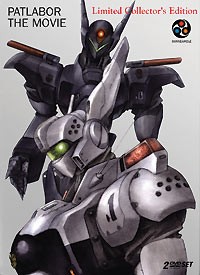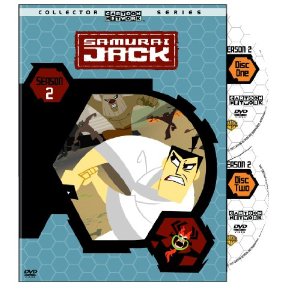Review Of Patlabor The Movie By Bandai Visual / Honneamise
-== What is it? ==-
Patlabor The Movie is a science fiction story set in a Tokyo that feels just a few years ahead of today. The movie was released in 1989 and is set in 1999. 😉 Patlabor tells the story of a group of police officers that try to unravel a plot set in motion by a brilliant computer scientist known as Eiichiro Hoba. The primary set pieces of the story are giant robots called “Labors” that the people of Tokyo use primarily for construction. Patlabor is actually part of a franchise that includes three movies, a TV show, and a manga. The first Patlabor movie stands completely on its own. Mamoru Oshii (Urusei Yatsura, Ghost In The Shell) directed the movie, Kazunori Ito penned the move, and the mecha were designed by Yutaka Izubuchi.
Patlabor has some robot violence but there is not any bloodletting. The movie contains no nudity and little to no adult content or themes. Patlabor is rated “13+” at RightStuf.com and I think that rating is accurate.
I purchased the Limited Collectors Edition boxed set from RightStuf.com during one of their sales. This edition includes the movie, a second DVD with many extras, plus two books. The movie itself is 83 minutes long.
-== What I Like ==-
The crux of the story in Patlabor is about the power of technology and the cost that it incurs when not kept in check. In the movie, just like in modern Japan, Tokyo Bay is being slowly filled in to facilitate new buildings. In Patlabor this redevelopment is being done as part of a government program called the Babylon Project. The story unfolds with the apparent suicide of a Eiichiro Hoba, a famed Labor programmer, and his “statement” against the Babylon Project. The story in Patlabor is not too complex and feels dated in several places but it is very well conveyed. Clues that the protagonists uncover are intuitive and clean. The trail of clues in Patlabor logically move the various characters along their main plot threads. Patlabor does not have gaps in the plot that can sometimes happen in foreign science fiction animation. The flow of the story is crisp yet does not feel hurried. This is a well crafted script. 🙂
The mecha designs by Izubuchi are wonderful. Construction labors look like they could have been build by Caterpillar. Police Labors have light bars like modern day police cars. Even though light bars on police mecha may sounds bit hokey I think it really nice design choice.
Background artwork in Patlabor is exceptionally strong. As the Babylon Project is an important part of the story these scenes are critical in conveying the motivation of Eiichiro Hoba. There is a particular scene in the movie where two detectives are investigating old residences of Hoba’s for clues. Instead of speaking the director runs a very moving piece of music and simply shows the detectives making there was through destroyed buildings, climbing down into sewer trenches, etc. This section of Patlabor conveys a key point of the story. The destroyed buildings show what technology and expansion can do to a city. More precisely they show how beautiful homes can be ravaged by the need to advance technology. It is a masterful bit of storytelling and movie direction.
The extras in the Limited Collectors Edition are extensive. Here is a high-level overview of the extras:
- Yuuki Masami Speaks – The writer of the Patlabor manga speaks about the focus of the story.
- 1999 Tokyo Image – Discussion of the Tokyo 1999 cityscape as presented in the movie. The narrator discusses how modern redevelopment is starting to close around Tokyo Bay like in Patlabor.
- Silicon City – A segment on technology and how it is utilized in Patlabor.
- Labors – Discussion with designers about the Labors. They mention intentional references to assembly lines and how they wanted to convey that feeling to the audience. They also discuss how Labors are treated like personal computers (PC). In PC the OS is what makes a Labor your own.
- Design – More discussion around the design of the primary characters.
- Sound & Music – A segment about the composer and sound in Patlabor.
- Ending – An overview of what the producers wanted to convey in the movie.
The two books in the Limited Collectors Edition package are awesome. The first book is called Patlabor The Movie Storyboards By Mamoru Oshii. It includes over 290 pages of black and white storyboards. Each page has 5 storyboards. These storyboards are incredibly detailed. Next to each hand drawn storyboard are handwritten notes from the director. At the end of the book are a set of abbreviations used by the team. The second book is called Patlabor The Movie Archives. This book is 180 pages and in full color. It includes background on movie, discussion of themes, a detailed staff list, maps, sketches, interviews, movie posters, promo material, etc. Both books are just fantastic and really make the Limited Collectors Edition package exceptional.
-== What I Don’t Like ==-
The main theme of Patlabor is a bit dated. Technology gone amok due to a computer virus is not really that novel these days. In 1989 is would have been more relevant.
-== Summary ==-
Patlabor is a wonderful movie with action, investigation, and drama. The Limited Collectors Edition boxed set moves what would be an above average product into something that all anime fans would be proud to display on their shelves. With the low $19.99 price tag at RightStuf.com you owe it to yourself to get a copy of the Patlabor The Movie 1 Limited Collectors Edition. 😀
You can get it from RightStuf.com at this URL for $19.99. That is such a great price on this wonderful boxed set. Why you are at RightStuff.com make sure to also get a copy of Patlabor The Movie 2 Limited Collectors Edition for the same low price. 😉
I give it 9 out of 10 paws.






